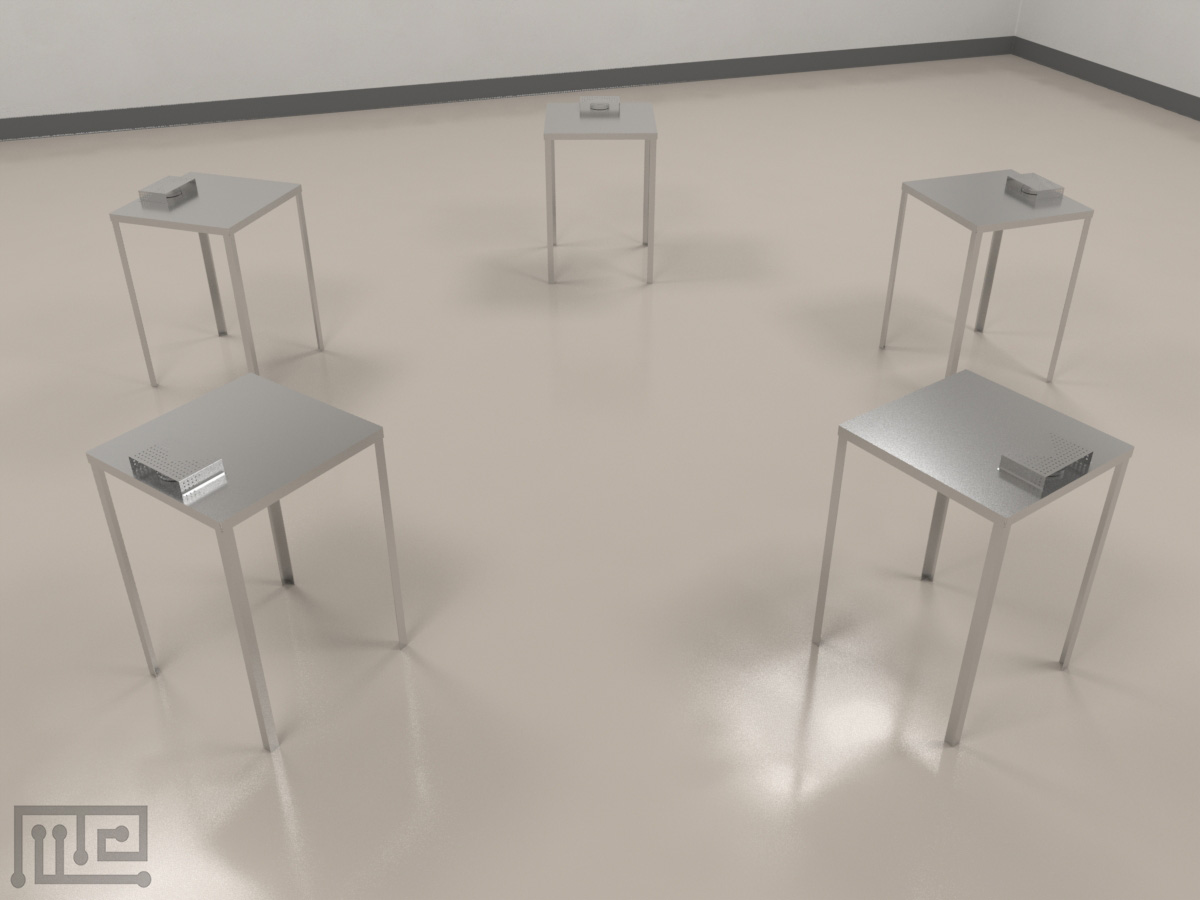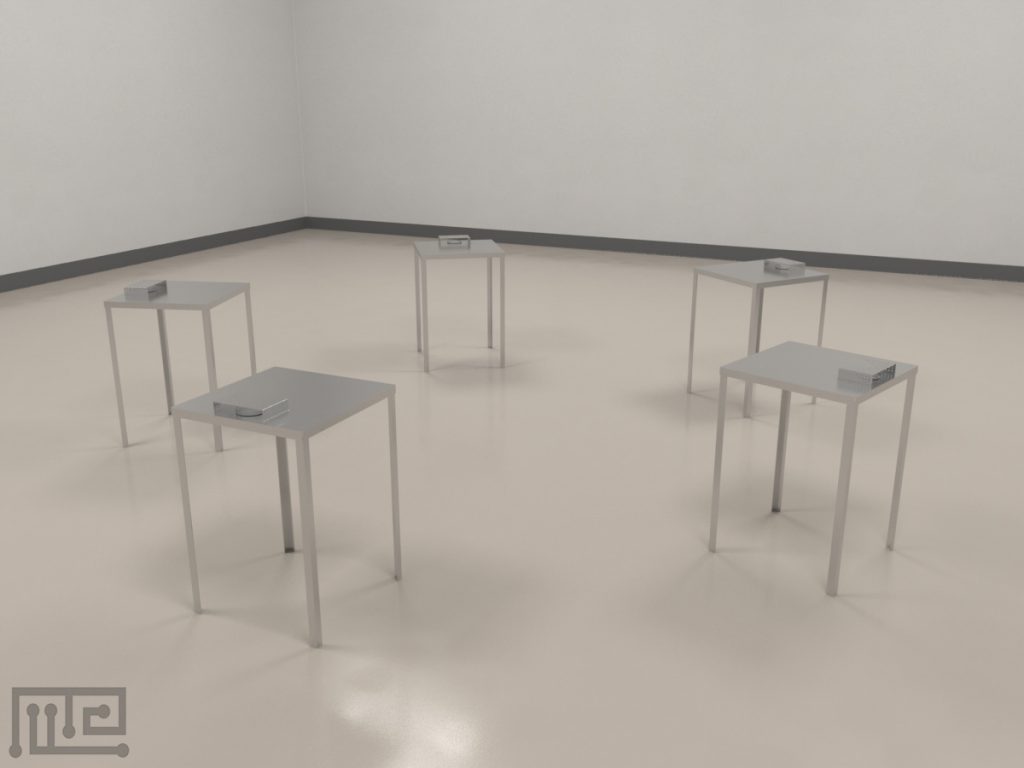The Dog Testing Arena was used to study olfactory discriminatory behavior in a free environment in dogs by Becker R. F et al. (1962).
It consisted of five angle-iron stations with perforated, stainless- steel tops arranged in a circle around a central rotary fan.
Dogs sniffed, in turn, at odor samples in Syracuse-type watch glasses, or on glass slides. The flat dishes or slides were housed under a raised, protective shield centered along the outer edge of each odor station. The perforated, stainless-steel shield prevented the animal from seeing the sample, from licking it, and from knocking it off the station.
Mazeengineers offer the Dog Testing Arena.
Price & Dimensions
Dog Testing Arena
$ 1990
+S&H- Diameter of circular arena: 8ft.
- Diameter of syracuse-type watch glasses: 65mm
- Diameter of glass slides: 3-in.by 1-in.
Documentation
Introduction
The Dog Testing Arena is used to study olfactory discrimination in dogs. Dogs are well-known to have an exceptional sense of smell and can reliably use their olfactory system to locate different odors (Horowitz, Hecht, & Dedrick, 2013). The Dog Testing Arena is a circular arena that contains odor stations that can adequately be used to observe behavioral responses to multiple odor cues. Since the arena provides the subjects with a free environment, escape from the arena is not prioritized, and the subjects can perform the task using their innate seeking and sniffing behaviors. In contrast to mazes such as the Dog T-maze that utilize a two-choice paradigm, the multiple-choice set-up of the Dog Testing Arena eliminates the 50% probability of making the correct choice.
Dogs use their visual system along with their olfactory system in the performance of spatial tasks. The Dog Testing Arena inhibits the subjects from utilizing visual cues to discriminate against the odor samples. The odor stations are equipped with perforated stainless steel shields that allow olfactory cues to emanate from the stations but prevents the odor samples from being visible. Moreover, the large central rotary fan helps rid the arena of odor cues between trials.
The Dog Testing Arena can be used as a translational tool to study the effect of age-related changes on the olfactory system. Furthermore, the effect of diseases and disorders on olfactory behaviors can also be studied. Other apparatuses used in the evaluation of dog behaviors include the Dog Canine Radial Arm Maze, the Dog DNMS Test Apparatus, and the Canine Plus Maze.
Apparatus and Equipment
The Dog Testing Arena is a circular arena measuring 8 ft. in diameter. The arena contains five angle-iron stations in which odor samples can be placed. The stations are equipped with perforated, stainless steel shields that prevent the odor source from being visible to the subjects as well as prevent access to it. The stations are arranged around a central rotary fan that is coupled with a large window-type evacuation fan that rid the arena of any odor cues.
Training Protocol
Clean the arena before and after every trial to prevent the influence of any odor cues from previous trials. Appropriately light the apparatus. A tracking and recording system such as the Noldus Ethovision XT can be used to assist with observations.
Training Trials
Train the subjects to sit on command to obtain a food reward. Place an odor sample in the odor stations and allow the subjects to sniff out the correct station. Reward the subject when it chooses the correct station. Place a test odor along with the odor sample in increasing amounts as trials progress until the subjects learn to sit on command to the test odor alone. Perform training trials for 3-5 weeks.
Discrimination Trials
Randomly place the test odor sample in one odor station and comparison samples in the other stations. Allow the subjects to enter the arena and sniff out the correct station. Reward the subject if it sits beside the correct station. If the subject sits beside the incorrect station, lead it out of the arena unrewarded. Allow the subjects to circle the arena in a maximum of two rounds before choosing an odor station if the subject doesn’t choose a station after circling twice, lead it out of the arena unrewarded.
Literature Review
Investigation on the ability of dogs to detect human odor traces
King, Becker, and Markee (1964) investigated if dogs could detect a human odor trace after it was placed in indoor storage or outdoor weathering. A fingerprinted slide served as the human odor sample and was tested along with four blank slides on the Dog Testing Arena. Two dogs (a mongrel fox terrier and a Weimaraner) were presented with the odor samples after being kept for 6, 12, 24, 48, 72, and 96 hours, as well as 1, 2, and 3 weeks. The subjects were alternately presented with the indoor and outdoor samples during 50 trials. Results from the indoor sample testing indicated that both the subjects could detect the odor sample at the end of 3 weeks and 6 weeks, however, the chance performance was observed by the end of 8 weeks. In contrast, the subjects’ performance scores were not as high when tested with the outdoor samples. The Weimaraner exhibited greater detecting ability of the two dogs. However, both dogs found it difficult to detect the outdoor samples after 48 hours of being outdoors.
Investigation on the ability of dogs to discriminate an odor sample
Becker, King, and Markee (1962) investigated if dogs could discriminate two odor samples (Substance A and Substance B) of very low vapor pressure on the Dog Testing Arena. The substances were dissolved in ethanol in a series of different concentrations, and a single drop was placed on a glass slide and placed at the odor stations. Absolute alcohol was used as the comparison stimulus and placed in the four other stations. The subjects were first presented with a dilution series of Substance A in ethanol from 1.54 × 10-2 to 1.54 ×10-9 mg per drop, per test sample. Results from the two best dogs that completed the task indicated that their successful responses declined steadily with decreasing concentration to the point of 1.54 ×10-8 mg. The threshold level was achieved at a concentration of 1.54 × 10-4 mg and was 4.14 ×10-4 mg per drop for Substance A. One of the subjects was then tested using a random order series of Substance B in ethanol at each concentration. Results indicated that the threshold for Substance B was 7.69 ×10-4 mg. Further tests were performed using Substance A in ethanol as the test order and Substance B in ethanol as the comparison stimulus in a dilution series of concentrations 1.54 × 10-2 to 1.54 × 10-6 mg. Results indicated that neither of the two subjects dropped within the range of chance expectancy. All points above 1.54 × 10-4 mg differed significantly from the average observed baseline of performance.
Data Analysis
The following can be observed using the Dog Testing Arena:
- Number of times the subject chose the correct odor station
- Number of times the subject chose the incorrect odor station
- Number of times the subject re-sniffed an odor station
- Number of times the subject circled the arena
- Time taken to complete a trial
Strengths and Limitations
Strengths
The Dog Testing Arena is a circular arena used to study olfactory discrimination in dogs. The arena comes equipped with multiple stations in which the odor samples can be placed. The stations contain perforated stainless steel shields that allow odor cues to emanate from each station but prevent the subjects from visual cues in the performance of the task. Furthermore, the arena also comes equipped with a large central rotary fan, which adequately helps rid the arena of odor cues after each trial. The Dog Testing Arena provides the subjects with a free environment that helps inhibit stress to escape from the apparatus. The Dog Testing Arena can be adapted for different experimental protocols such as those exploring behavioral flexibilities as well as learning and memory behaviors in dogs.
Limitations
The exploratory drive of the subject is highly important in the completion of the task. Unintentional stimuli may affect the way the subjects perform the task. Factors such as age, gender, or strain of the subjects may affect task performance.
Summary
- The Dog Testing Arena is used to study olfactory discrimination in dogs.
- It is a circular arena that contains five odor stations arranged around a central rotary fan.
- The odor stations are equipped with stainless steel shields that prevent access to the odor sample as well as keeps the sample out of sight.
- The free environment of the Dog Testing Arena inhibits stressful responses to escape from the apparatus.
References
- Becker, R. F., King, J. E., & Markee, J. E. (1962). Studies on olfactory discrimination in dogs: II. Discriminatory behavior in a free environment. Journal of comparative and physiological psychology, 55(5), 773. doi:10.1037/h0042155
- Horowitz, A., Hecht, J., & Dedrick, A. (2013). Smelling more or less: Investigating the olfactory experience of the domestic dog. Learning and Motivation, 44(4), 207–217. doi:10.1016/j.lmot.2013.02.002
- King, J. E., Becker, R. F., & Markee, J. E. (1964). Studies on olfactory discrimination in dogs:(3) Ability to detect human odour trace. Animal Behaviour, 12(2-3), 311-315. doi:10.1016/0003-3472(64)90017-x




